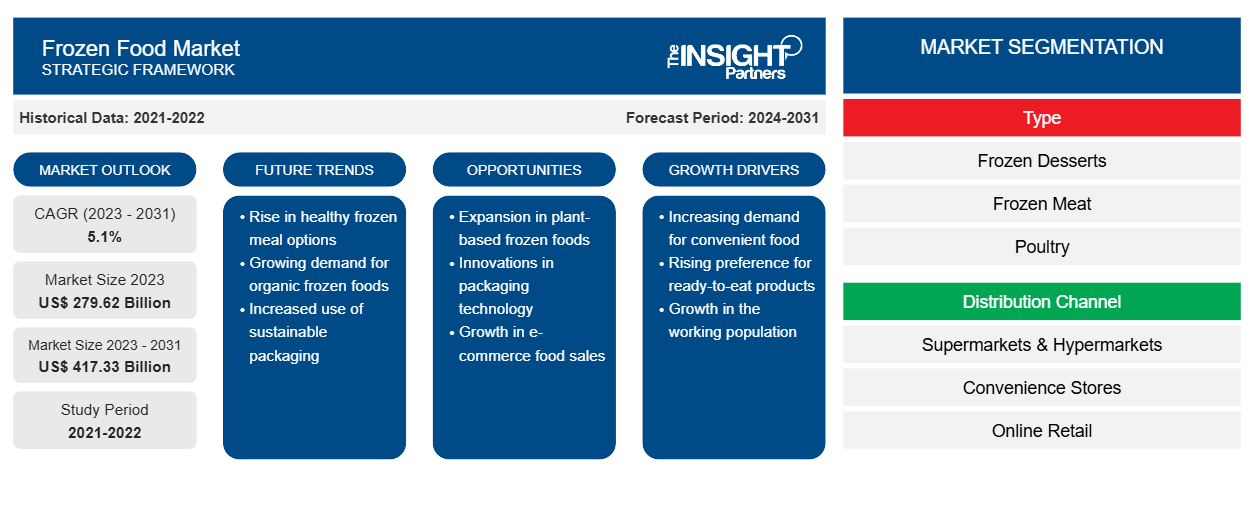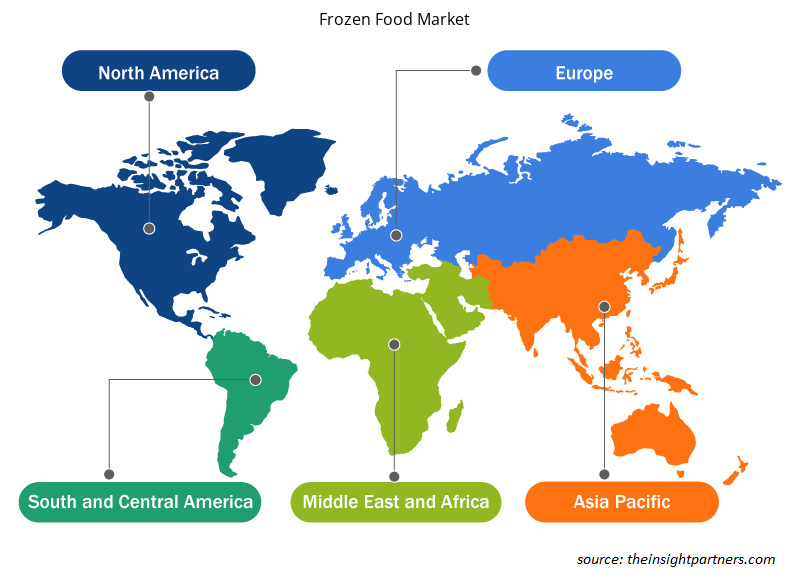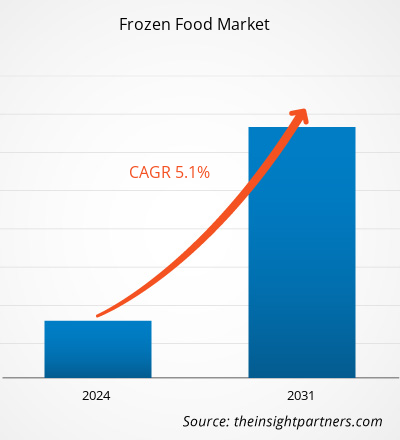Der Markt für Tiefkühlkost soll von 295,39 Millionen US-Dollar im Jahr 2024 auf 444,22 Millionen US-Dollar im Jahr 2031 anwachsen; im Prognosezeitraum wird voraussichtlich eine durchschnittliche jährliche Wachstumsrate (CAGR) von 6,0 % verzeichnet. Veganismus hat in den letzten Jahren deutlich an Bedeutung gewonnen. Verbraucher bevorzugen pflanzliche Produkte, da sie diese als gesünder als konventionelle Produkte empfinden. Das zunehmende Bewusstsein für Tierschutz und ökologische Nachhaltigkeit trägt zudem zur Beliebtheit dieser Lebensmittel bei. Die weltweite Verbreitung des Veganismus beeinflusst Innovationen im Tiefkühlkostmarkt maßgeblich.
Marktanalyse für Tiefkühlkost
In den letzten Jahren hat sich der Lebensstil der Menschen weltweit dramatisch verändert. Hektische Arbeitsalltage haben die Abhängigkeit der Menschen von zeit- und arbeitssparenden Produkten verstärkt. Der steigende Konsum hochwertiger Fertiggerichte ist einer der größten Trends in der Lebensmittelindustrie. Convenience Food wie Tiefkühlsnacks, Tiefkühlgerichte, Aufschnitt und Fertigprodukte sparen Verbrauchern Zeit und Aufwand beim Einkauf von Zutaten, bei der Zubereitung und Zubereitung von Mahlzeiten, beim Verzehr und bei der Nachbereitung. Die Entwicklung und Beliebtheit dieser Lebensmittel ist auf viele gesellschaftliche Veränderungen zurückzuführen; die wichtigsten davon sind die zunehmende Zahl kleinerer Haushalte und die wachsende Zahl der Millennials weltweit. Aufgrund hektischer Arbeitsalltage nutzen Millennials ihre Zeit lieber effizient, anstatt sie mit mühsamen Aufgaben zu verbringen. Daher geben sie ihr Geld eher für Fertiggerichte aus. Diese Faktoren steigern die Nachfrage nach Convenience Food deutlich und beflügeln letztendlich das Wachstum des Tiefkühlkostmarktes.
Marktübersicht für Tiefkühlkost
Tiefkühlkost umfasst Eiscreme, gefrorenen Joghurt, gefrorenes Fleisch, gefrorene Meeresfrüchte, gefrorene Fertiggerichte, Snacks, Vorspeisen, Suppen, Obst und Gemüse. Diese Produkte werden durch Einfrieren bei etwa -25 Grad Celsius haltbar gemacht. Tiefkühlkost enthält keine künstlichen Konservierungsstoffe und ist daher gesünder als andere verarbeitete Lebensmittel. Zudem lässt sie sich problemlos in Haushaltsgefrierschränken bei -18 Grad Celsius lagern. Die steigende Nachfrage nach Fertiggerichten aufgrund des hektischen Lebensstils treibt das Wachstum des Tiefkühlkostmarktes voran. Darüber hinaus sind die rasante Urbanisierung, das steigende Pro-Kopf-Einkommen und die veränderte Einzelhandelssituation einige der wichtigsten Wachstumsfaktoren für den Tiefkühlkostmarkt.
Passen Sie diesen Bericht Ihren Anforderungen an
Sie erhalten kostenlos Anpassungen an jedem Bericht, einschließlich Teilen dieses Berichts oder einer Analyse auf Länderebene, eines Excel-Datenpakets sowie tolle Angebote und Rabatte für Start-ups und Universitäten
Markt für Tiefkühlkost: Strategische Einblicke

-
Informieren Sie sich über die wichtigsten Markttrends in diesem Bericht.Dieses KOSTENLOSE Beispiel umfasst Datenanalysen, von Markttrends bis hin zu Schätzungen und Prognosen.
Treiber und Chancen auf dem Tiefkühlkostmarkt
Aufschwung des E-Commerce begünstigt den Markt
Immer mehr Menschen bevorzugen Online-Einzelhandelsplattformen für den Kauf von Tiefkühlkost. Laut American Frozen Food Institute stiegen die Online-Verkäufe von Tiefkühlkostprodukten im Jahr 2020 um 75 %. Während der Pandemie stiegen die Online-Verkäufe von Lebensmitteln und Getränken aufgrund der Schließung von stationären Geschäften und der von Regierungen verhängten sozialen Einschränkungen deutlich an. Da die Bewegungsfreiheit der Menschen durch Lockdowns eingeschränkt war und sie gezwungen waren, von zu Hause aus zu arbeiten, gab es eine erhebliche Verlagerung zum Online-Shopping. Darüber hinaus waren hohe Rabatte, die große Verfügbarkeit verschiedener Marken unter einem Dach und die Möglichkeit der Lieferung nach Hause weitere wichtige Faktoren, die die Aufmerksamkeit der Verbraucher auf das Online-Shopping lenkten. Mit der zunehmenden Durchdringung des E-Commerce in verschiedenen Regionen bauen auch Hersteller von Tiefkühlkost wie Kellogg's Company und Conagra Brands ihre Online-Präsenz aus, indem sie ihre Produkte über bekannte E-Commerce-Plattformen wie Amazon.com, Lidl und Walmart verkaufen. Dieser Faktor trägt zum Wachstum des Tiefkühlkostmarktes bei, indem er die Abhängigkeit von stationären Einzelhandelsgeschäften beseitigt.
Strategische Entwicklungsinitiativen von Herstellern – eine Chance
Hersteller von Tiefkühlkost investieren erheblich in Produktinnovationen, um ihren Kundenstamm zu erweitern und auf neue Verbrauchertrends zu reagieren. Sie bringen glutenfreie, pflanzliche, zuckerfreie, Bio- und Clean-Label-Produkte sowie für eine Keto-Diät geeignete Produkte auf den Markt, die den vielfältigen Anforderungen der Verbraucher gerecht werden. So kündigte beispielsweise die Real Good Foods Company, ein bekannter Name in der Tiefkühlkostbranche, im August 2021 die Einführung von sieben neuen proteinreichen, kohlenhydratarmen, getreidefreien und glutenfreien Tiefkühlproduktkategorien in 1.500 Kroger-Filialen in den USA an. Ebenso hat die führende indische Marke Prasuma, die Tiefkühlkost anbietet, im Jahr 2022 ihr Tiefkühlproduktportfolio um Tiefkühlsnacks erweitert. Zu den neu eingeführten Produkten gehören Tiefkühl-Frühlingsrollen mit Gemüse und Hühnchen, Tiefkühl-Chicken Nuggets, Mini-Samosas mit Hühnchen und Gemüse, Shammi-Kebabs mit Hühnchen und Hammel und Seekh-Kebabs sowie Speck. Diese Produkte wurden eingeführt, um Verbrauchern zu helfen, ihre Gesundheitsziele zu erreichen und gleichzeitig eine gute Mahlzeit zu genießen, da Gesundheit während der globalen Krise für Verbraucher weltweit zur Priorität wurde. Da die Menschen zunehmend auf Fertiggerichte setzen und gleichzeitig auf eine ausgewogene Ernährung achten, bringen Hersteller nährstoffangereicherte Tiefkühlprodukte auf den Markt. Solche Produktinnovationen helfen ihnen, ihre Reichweite zu vergrößern und sich einen Wettbewerbsvorteil auf den internationalen Märkten zu verschaffen.
Segmentierungsanalyse des Marktberichts für Tiefkühlkost
Schlüsselsegmente, die zur Ableitung der Marktanalyse für Tiefkühlkost beigetragen haben, sind Typ und Vertriebskanal.
- Der Markt für Tiefkühlkost ist nach Typ unterteilt in Tiefkühldesserts, Tiefkühlfleisch, -geflügel und -meeresfrüchte, Tiefkühlbackwaren, Tiefkühlsnacks und -vorspeisen, Tiefkühlgerichte und Sonstiges.
- Hinsichtlich der Vertriebskanäle ist der Markt in Supermärkte und Hypermärkte , Convenience Stores, Online-Einzelhandel und andere unterteilt.
Marktanteilsanalyse für Tiefkühlkost nach geografischer Lage
Der geografische Umfang des Berichts zum Markt für Tiefkühlkost ist hauptsächlich in fünf Regionen unterteilt: Nordamerika, Asien-Pazifik, Europa, Naher Osten und Afrika sowie Südamerika/Süd- und Mittelamerika.
Europa dominiert den Markt für Tiefkühlkost. Er ist in Deutschland, Frankreich, Italien, Großbritannien, Russland und das übrige Europa unterteilt. Das Marktwachstum ist vor allem auf die steigende Nachfrage nach Fertiggerichten, die dichte Einzelhandelsinfrastruktur und die Verfügbarkeit einer breiten Produktpalette verschiedener Marken über verschiedene Vertriebskanäle zurückzuführen. Auch die Präsenz von Verbrauchern mit hohem Pro-Kopf-Einkommen treibt die Nachfrage nach Tiefkühlkost, wie z. B. Tiefkühlgerichten und Snacks, an. Verbraucher legen Wert auf einen hohen Nährwert ihrer Produkte. Daher ist die Nachfrage nach sauberen, biologischen, glutenfreien und minimal verarbeiteten Tiefkühlkostprodukten deutlich gestiegen, was das Marktwachstum in der Region beflügelt.
Regionale Einblicke in den Markt für Tiefkühlkost
Die Analysten von Insight Partners haben die regionalen Trends und Einflussfaktoren auf den Tiefkühlkostmarkt im Prognosezeitraum ausführlich erläutert. In diesem Abschnitt werden auch die Marktsegmente und die geografische Lage in Nordamerika, Europa, Asien-Pazifik, dem Nahen Osten und Afrika sowie Süd- und Mittelamerika erörtert.

- Erhalten Sie regionale Daten zum Markt für Tiefkühlkost
Umfang des Marktberichts über Tiefkühlkost
| Berichtsattribut | Details |
|---|---|
| Marktgröße im Jahr 2024 | 295,39 Millionen US-Dollar |
| Marktgröße bis 2031 | 444,22 Millionen US-Dollar |
| Globale CAGR (2025 – 2031) | 6,0 % |
| Historische Daten | 2021-2023 |
| Prognosezeitraum | 2025–2031 |
| Abgedeckte Segmente |
Nach Typ
|
| Abgedeckte Regionen und Länder |
Nordamerika
|
| Marktführer und wichtige Unternehmensprofile |
|
Marktdichte von Tiefkühlkost: Einfluss auf die Geschäftsdynamik
Der Markt für Tiefkühlkost wächst rasant. Die steigende Endverbrauchernachfrage ist auf Faktoren wie veränderte Verbraucherpräferenzen, technologische Fortschritte und ein stärkeres Bewusstsein für die Produktvorteile zurückzuführen. Mit der steigenden Nachfrage erweitern Unternehmen ihr Angebot, entwickeln Innovationen, um den Verbraucherbedürfnissen gerecht zu werden, und nutzen neue Trends, was das Marktwachstum weiter ankurbelt.
Die Marktteilnehmerdichte beschreibt die Verteilung der in einem bestimmten Markt oder einer bestimmten Branche tätigen Unternehmen. Sie gibt an, wie viele Wettbewerber (Marktteilnehmer) in einem bestimmten Marktraum im Verhältnis zu dessen Größe oder Gesamtmarktwert präsent sind.
Die wichtigsten Unternehmen auf dem Markt für Tiefkühlkost sind:
- Conagra-Marken
- General Mills
- Pepperidge Farm Incorporated
- Bonduelle-Gruppe
- McCain Foods Limited
- Bellisio Foods, Inc.
Haftungsausschluss : Die oben aufgeführten Unternehmen sind nicht in einer bestimmten Reihenfolge aufgeführt.

- Überblick über die wichtigsten Akteure auf dem Markt für Tiefkühlkost
Neuigkeiten und aktuelle Entwicklungen auf dem Tiefkühlkostmarkt
Der Markt für Tiefkühlkost wird anhand qualitativer und quantitativer Daten aus Primär- und Sekundärforschung bewertet. Dazu zählen wichtige Unternehmenspublikationen, Verbandsdaten und Datenbanken. Nachfolgend finden Sie eine Liste der Entwicklungen im Markt für Sprach- und Sprechstörungen sowie Strategien:
- Im Jahr 2022 erweitert White Castle sein Lebensmittelangebot im Einzelhandel durch eine Partnerschaft mit Bellisio Foods, um die legendären Chicken Rings landesweit in den Einzelhandel zu bringen (Whistle Castle/Unternehmenswebsite)
Marktbericht für Tiefkühlkost – Umfang und Ergebnisse
Der Bericht „Marktgröße und Prognose für Tiefkühlkost (2021–2031)“ bietet eine detaillierte Analyse des Marktes, die die folgenden Bereiche abdeckt:
- Marktgröße und Prognose auf globaler, regionaler und Länderebene für alle wichtigen Marktsegmente, die im Rahmen des Berichts abgedeckt sind
- Marktdynamik wie Treiber, Hemmnisse und wichtige Chancen
- Wichtige Zukunftstrends
- Detaillierte PEST/Porters Five Forces- und SWOT-Analyse
- Globale und regionale Marktanalyse mit wichtigen Markttrends, wichtigen Akteuren, Vorschriften und aktuellen Marktentwicklungen
- Branchenlandschaft und Wettbewerbsanalyse, einschließlich Marktkonzentration, Heatmap-Analyse, prominenten Akteuren und aktuellen Entwicklungen
- Detaillierte Firmenprofile
- Historische Analyse (2 Jahre), Basisjahr, Prognose (7 Jahre) mit CAGR
- PEST- und SWOT-Analyse
- Marktgröße Wert/Volumen – Global, Regional, Land
- Branchen- und Wettbewerbslandschaft
- Excel-Datensatz
Aktuelle Berichte
Verwandte Berichte
Erfahrungsberichte
Grund zum Kauf
- Fundierte Entscheidungsfindung
- Marktdynamik verstehen
- Wettbewerbsanalyse
- Kundeneinblicke
- Marktprognosen
- Risikominimierung
- Strategische Planung
- Investitionsbegründung
- Identifizierung neuer Märkte
- Verbesserung von Marketingstrategien
- Steigerung der Betriebseffizienz
- Anpassung an regulatorische Trends






















 Kostenlose Probe anfordern für - Markt für Tiefkühlkost
Kostenlose Probe anfordern für - Markt für Tiefkühlkost